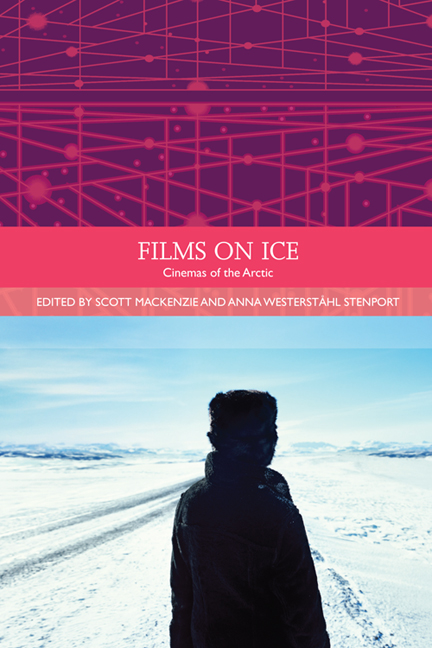Book contents
- Frontmatter
- Contents
- List of Illustrations
- Acknowledgements
- Traditions in World Cinema
- Introduction: What are Arctic Cinemas?
- PART I GLOBAL INDIGENEITY
- PART II HOLLYWOOD HEGEMONY
- PART III ETHNOGRAPHY AND THE DOCUMENTARY DILEMMA
- 14 The Creative Treatment of Alterity: Nanook as the North
- 15 From Objects to Actors: Knud Rasmussen's Ethnographic Feature Film The Wedding of Palo
- 16 Arctic Travelogues: Conquering the Soviet North
- 17 A Gentle Gaze on the Colony: Jette Bang's Documentary Filming in Greenland 1938–9
- 18 Exercise Musk-Ox: The Challenges of Filming a Military Expedition in Canada's Arctic
- 19 The Tour: A Film About Longyearbyen, Svalbard. An Interview with Eva la Cour
- PART IV MYTHS AND MODES OF EXPLORATION
- Notes on the Contributors
- Index
14 - The Creative Treatment of Alterity: Nanook as the North
from PART III - ETHNOGRAPHY AND THE DOCUMENTARY DILEMMA
Published online by Cambridge University Press: 05 September 2016
- Frontmatter
- Contents
- List of Illustrations
- Acknowledgements
- Traditions in World Cinema
- Introduction: What are Arctic Cinemas?
- PART I GLOBAL INDIGENEITY
- PART II HOLLYWOOD HEGEMONY
- PART III ETHNOGRAPHY AND THE DOCUMENTARY DILEMMA
- 14 The Creative Treatment of Alterity: Nanook as the North
- 15 From Objects to Actors: Knud Rasmussen's Ethnographic Feature Film The Wedding of Palo
- 16 Arctic Travelogues: Conquering the Soviet North
- 17 A Gentle Gaze on the Colony: Jette Bang's Documentary Filming in Greenland 1938–9
- 18 Exercise Musk-Ox: The Challenges of Filming a Military Expedition in Canada's Arctic
- 19 The Tour: A Film About Longyearbyen, Svalbard. An Interview with Eva la Cour
- PART IV MYTHS AND MODES OF EXPLORATION
- Notes on the Contributors
- Index
Summary
This chapter considers Robert Flaherty's Nanook of the North (US, 1922) – probably the most famous Arctic film ever made – and the many, often fraught, reiterations of the film in the cinematic imaginary of the Arctic. Starting with Flaherty's film – typically understood to be, pace John Grierson, the first ‘documentary’ – the chapter examines the ways in which the stories of ‘Nanook’ (played by Inuit hunter Allakariallak) and Flaherty have been continuously rearticulated throughout cinema history, in works as diverse as realist ethnographic documentaries like Nanook Revisited (Claude Massot, France, 1990), narrative feature film retellings of Flaherty's filming in the Arctic such as Kabloonak (Claude Massot, Canada/France, 1994), experimental documentaries like Philip Hoffman and Sami van Ingen's Sweep (Canada, 1995), to the recent 3D IMAX film To the Arctic (Greg MacGillivray, US, 2012), and Inuit film and video retellings of the past, in part as a riposte to Flaherty, such as the Netsilik film series (made in conjunction with filmmakers from the National Film Board of Canada) and the Nunavut series (made by the Inuit group Isuma).
A key question that is often asked about Nanook of the North is: what is the status of Nanook? Is this a documentary portrayal, a fictional creation or some hybrid of the two? To answer this question, we need to reframe it with another one, implicit in all the critiques of Nanook of the North but seldom addressed, namely: what is the status of Flaherty? By this, I mean not what is his status as a filmmaker, but what is his status within the imaginary history of the film's production and the myths about Nanook of the North that descend from and circle around it? If one begins to understand the signification of ‘Flaherty’, one can also begin to unravel the contested and contestatory debates that underlie the film, the reiterations of its history, and the reappropriation of its images in other films.
A secondary question that arises is why have the images from Nanook of the North taken such a central role in the conceptualisation of the cinematic image of the Arctic, as if it were a space in time frozen in history.
- Type
- Chapter
- Information
- Films on IceCinemas of the Arctic, pp. 201 - 214Publisher: Edinburgh University PressPrint publication year: 2014



